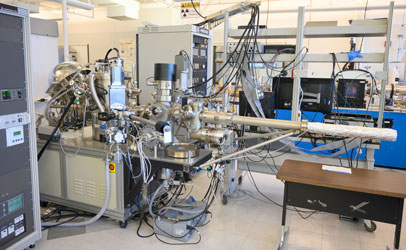 XPS, also known as ESCA (Electron Spectroscopy for Chemical Analysis), is a surface-sensitive
technique used to determine elemental composition and chemical bonding states. The
sample is irradiated with mono-energetic X-rays, causing electrons to be emitted.
An electron energy analyzer determines the binding energy of these photoelectrons.
From the binding energy and intensity of a photoelectron peak, the elemental identity,
its chemical state and concentration are determined. The information the XPS technique
provides about surface layers and thin film structures is of value in many applications,
including corrosion, adhesion, semiconductor and dielectric materials, electronics
packaging, magnetic media, polymer surface modification, catalysis, thin film coatings
and more. The ADL owns a PHI 5000 Versaprobe, Scanning ESCA Microprobe from Physical
Electronics. Its main features are:
XPS, also known as ESCA (Electron Spectroscopy for Chemical Analysis), is a surface-sensitive
technique used to determine elemental composition and chemical bonding states. The
sample is irradiated with mono-energetic X-rays, causing electrons to be emitted.
An electron energy analyzer determines the binding energy of these photoelectrons.
From the binding energy and intensity of a photoelectron peak, the elemental identity,
its chemical state and concentration are determined. The information the XPS technique
provides about surface layers and thin film structures is of value in many applications,
including corrosion, adhesion, semiconductor and dielectric materials, electronics
packaging, magnetic media, polymer surface modification, catalysis, thin film coatings
and more. The ADL owns a PHI 5000 Versaprobe, Scanning ESCA Microprobe from Physical
Electronics. Its main features are:
- Highly automated instrument that uses focused monochromatic Al (Kα) X-rays for spatially resolved chemical analysis
- X-ray spot size ranges from 10 μm to 200 μm
- Allows micro and macro area XPS
- Equipped with Ar sputtering gun for surface cleaning and depth profiling
- Non-conducting samples can be charge-compensated by the electron flood gun and very low energy Ar ions
- X-ray-induced secondary electron (SXI) imaging capability to identify location of interest for micro XPS
- Scanning capabilities for chemical state mapping
- Angle-resolved analysis for non-destructive depth profiling of ultrathin films
- Equipped with Hemispherical Analyzer with 16 channels
- Accommodates 25 mm and 60 mm sample holders
Instrument Manager: Anju Sharma
Backup: Dae Young Jung